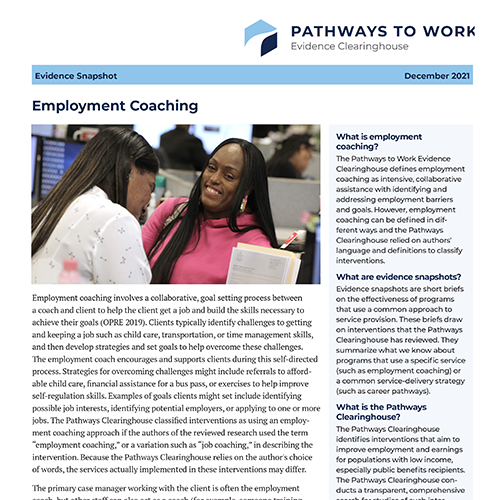The Pathways to Work Evidence Clearinghouse defines employment coaching as intensive, collaborative assistance with identifying and addressing employment barriers and goals. Clients typically identify challenges to getting and keeping a job such as child care, transportation, or time management skills, and then develop strategies and set goals to help overcome these challenges. This Evidence Snapshot describes the effectiveness of programs that were identified by the Pathways Clearinghouse as using employment coaching. It summarizes what we know about these programs and their impacts so TANF administrators, policymakers, researchers, and the general public can apply the evidence to questions and contexts that matter to them.
Key Findings and Highlights
On average, interventions that use employment coaching improved outcomes, especially earnings and education and training. In particular, for intervention participants -- as compared with comparison groups that did not receive intervention services
- Short-term annual earnings increased by $696 and long-term annual earnings increased by $639, on average, across the 14 interventions that measured the impact of employment coaching on earnings.
- Short-term and long-term employment increased by an average of 1 percentage point across the 16 interventions that examined these outcomes.
- On average, within studies measuring public benefits, short-term benefit receipt did not change, long-term benefit receipt increased by 1 percentage point, and the amount of public benefits received increased by $30 in the short term and $137 in the long term.
- Education and training attainment increased by 13 percentage points across the six studies that measured changes in education.
- Three interventions with employment coaching improved more than one type of outcome.
Citation
Cattell, Lindsay, Jillian Stein, and Dana Rotz (2021). Evidence Snapshot: Employment Coaching. OPRE Report # 2021-190, Washington, DC: Office of Planning, Research, and Evaluation, Administration for Children and Families, U.S. Department of Health and Human Services.




